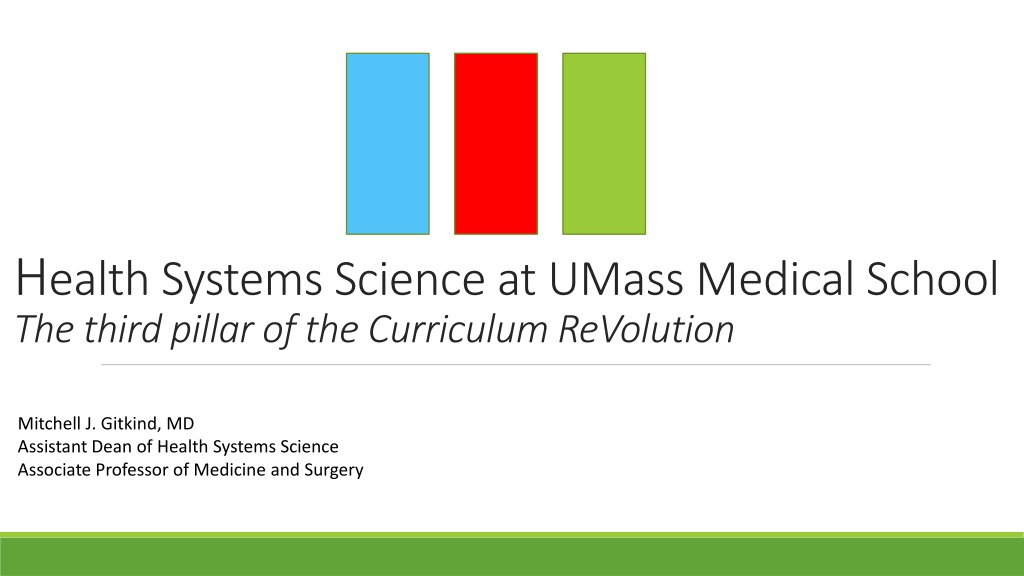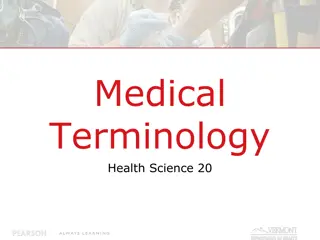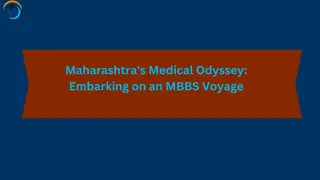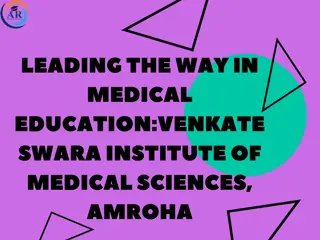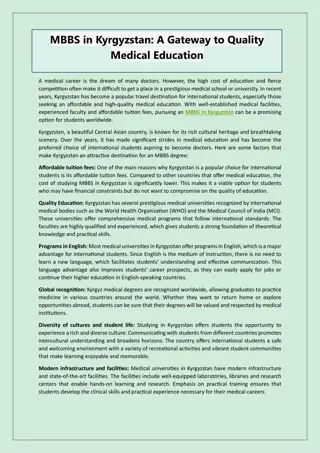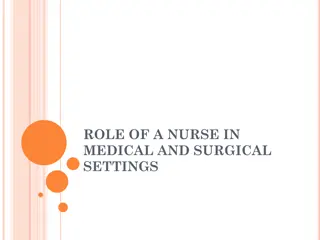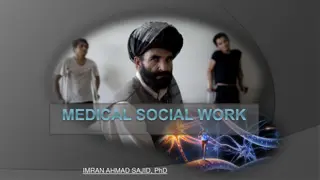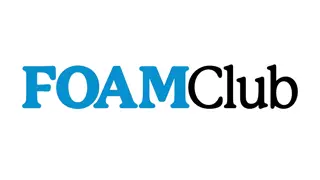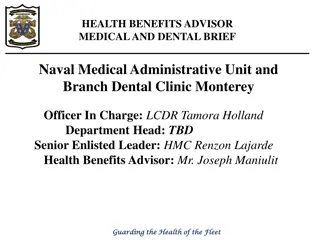Exploring Health Systems Science in Medical Education
Health Systems Science (HSS) is a crucial component in modern medical education, emphasizing the delivery and reception of healthcare by patients and populations. This approach expands traditional medical knowledge to include topics such as value-based care, social determinants of health, and leadership, preparing future healthcare professionals to navigate complex healthcare systems effectively.
Download Presentation

Please find below an Image/Link to download the presentation.
The content on the website is provided AS IS for your information and personal use only. It may not be sold, licensed, or shared on other websites without obtaining consent from the author. Download presentation by click this link. If you encounter any issues during the download, it is possible that the publisher has removed the file from their server.
E N D
Presentation Transcript
Health Systems Science at UMass Medical School The third pillar of the Curriculum ReVolution Mitchell J. Gitkind, MD Assistant Dean of Health Systems Science Associate Professor of Medicine and Surgery
Medical Education: Traditional vs. HSS model Basic Clinical Basic Clinical Health Systems
HSS definition How health care is delivered to and received by patients and populations Adapted from Skochelak et al. Health Systems Science. Elsevier, 2019
Knowledge limited to the scientific basis of disease, diagnosis, and treatment is no longer enough Traditional medical education Government role Adapted from: Skochelak et al. Health Systems Science. Elsevier, 2019; Gonzalo, et al. Aligning Education with Health Care Transformation, Acad Med. 2018 Feb; www.ama-assn.org/education/creating-medical-school-future
Case-based teaching through HSS lens: Evaluation and management of chronic congestive heart failure TRADITIONAL TOPICS HSS TOPICS History and physical ED vs. outpatient management Chest x-ray Readmissions/coordination/transitions of care Pathophysiology Interprofessional collaboration Medications Value-based care Diet Social determinants of health Payment models Adapted from: Skochelak et al. Health Systems Science. Elsevier, 2019
Health Systems Science education at UMMS 2020-2021 academic year DOMAINS NEEDING MORE REPRESENTATION DOMAINS THAT EXIST BUT WITH OPPORTUNITIES TO IMPROVE WELL-REPRESENTED DOMAINS Systems thinking High-value care, evidence- based medicine Social determinants of health Leadership Informatics Population health Interprofessional care/teamwork Quality improvement and patient safety Structures and processes Policy, economics, management Patient-centered care Ethics and legal aspects
HSS domain drill-down: The US healthcare system's structures and processes Definition: The individuals, institutions, resources, and actions that deliver healthcare Domain includes: Settings within which care is delivered (hospitals, emergency departments, ambulatory) Coordination vs. fragmentation of care within and between settings Experience-of-care from patient and family perspective Roles and functioning of members of interprofessional teams Curricular content example: Script the transfer of a discharged inpatient to a skilled nursing facility, including differences in levels of care, coordination, personnel involved, criteria for acceptance, records transfer Skochelak et al. Health Systems Science. Elsevier, 2019
Drill-down: Policy, economics, management Definition: The decisions, plans, and activities undertaken to achieve healthcare goals within a society, and the allocation and management of resources to achieve these goals Domain includes: Historical, future, and international perspectives on the provision of health care Roles of government and private entities Finance, insurance, reimbursement models Curricular content example: Identify two patients you are taking care of who have different insurance statuses (government-sponsored, private, under-/un-insured) and require the same common test or procedure. Investigate and record how hospitals or clinics providing this service are reimbursed for these two patients. Include costs to the patient in your analysis www.who.int/topics/health_policy/en/ Skochelak et al. Health Systems Science. Elsevier, 2019
Drill-down: Informatics Definition: The design, development, and application of information technology in health care Domain includes: Advantages and vulnerabilities of electronic health records, including patient portals Privacy and security of data within electronic health records EHR interoperability Use of electronically generated data for individual and group decision making Related: Social media issues, Internet information use by providers and patients Curricular content examples: 1. Identify a patient not enrolled in the patient portal. Assist them in doing so and accessing the main features including reviewing their own records. Note challenges. Identify a patient who receives care in multiple systems and use the information from another institution s electronic record to improve care. 2. Research how to run a report to improve care in an area of interest for your Longitudinal Preceptor Program clinic and outline the process. 3. Look at a registry of patients in Epic (i.e. COPD, CHF, filter for a specific practice and analyze care for this disease at this practice United States National Library of Medicine, 2019; Skochelak et al. Health Systems Science. Elsevier, 2019
Drill-down: Population health and social determinants Definition: The health outcomes of a group of individuals, including the distribution of outcomes within the group; which are the product of multiple determinants Domain includes: Social determinants of health, including risk behaviors Health disparities and inequity The roles of culture, language, and socio-economic issues Curricular content examples: 1. Update and enhance social and behavioral determinants within the EHR for one of your LPP patients. Identify local resources to support the patient's needs using the EHR's tools. 2. Identify an article related to treatment for a patient you are caring for and analyze how it addresses social determinants of health (impact on diagnosis, access to care or treatment, etc.). 3. Review a patient's discharge instructions. How do social determinants impact their potential adherence to these instructions? cdc.gov/pophealthtraining; Skochelak et al. Health Systems Science. Elsevier, 2019
Drill-down: High-value care Definition: The best care for the patient, with optimal results for the circumstances, delivered at the right price Domain includes: Prioritizing care that is safe, timely, effective, efficient, equitable, and patient-centered Analyzing relative benefits, harms, and costs of interventions Identifying strategies to decrease or eliminate the use of interventions that provide no benefit, may cause harm, or both Curricular content examples: 1. Work as a team to select a disease entity (prostate cancer, viral conjunctivitis, low back pain, etc). Review the treatment options, costs, and benefits and create a summary. Outline how you would describe this to patients (draft actual language). 2. Analyze the ordering of an imaging test relative to the ACR's decision support tools that determine the highest value test to answer your clinical question. 3. "Use the "Choosing Wisely" website to find examples of high-value care for correlation with a clinical scenario National Academy of Medicine, 2013; Skochelak et al. Health Systems Science. Elsevier, 2019
Drill-down: Quality improvement Definition: Identifying and responding to opportunities for change that leads to better patient outcomes, system performance, and professional development Domain includes: Links to value-based care and patient safety High reliable organizations Quality measurement, public reporting, hospital and healthcare system ratings Problems, current condition maps, root causes, goals, Plan-Do-Study-Act (PDSA) cycles Curricular content example: Work as a team to apply a quality improvement model to a problem selected from a list (or publicly accessible quality metric identified by your team). Outline the current condition, root causes, goals and draft a PDSA cycle. Examples include avoidance of needle sticks, handwashing adherence, operating room turnaround time, crowding in charting areas, waking patients for rounding Skochelak et al. Health Systems Science. Elsevier, 2019
Drill-down: Patient Safety Definition: The reduction of risk of unnecessary harm associated with health care Domain includes: - Medical errors including differences between slips and mistakes - Near misses - The role of safety event reporting - Safety event investigation Curricular content examples: 1. Investigate the process that is triggered after a hospital inpatient is given an accidental overdose of insulin, including identifying possible root causes and countermeasures to prevent recurrence. 2. Research the literature related to safety event-related disclosure and apology and create a 10- minute video summary of key points to share with your class World Health Organization, 2011; Skochelak et al. Health Systems Science. Elsevier, 2019
Drill-down: Ethics and legal aspects Definition: Respecting laws while also recognizing requirements that may run contrary to the best interests of patients Domain includes: - Conflicts of interest, fraud, and abuse -Regulation and market competition -Privacy and confidentiality -Informed consent Curricular content examples: 1. Create a role-play appropriate to 3rd year students that illustrates how to respond to issues of privacy or confidentiality that may have been violated. 2. Draft a case for students to work through in which there is a complication to a common moderate-risk procedure; provide reading related to informed consent and the details of this procedure. Students work in dyads to explain the procedure to a peer and then describe and discuss the complication that occurred (students did not have the information about the complication in advance). Discuss whether this was understood from the consent process? what could have been improved and how? How did it feel to be the provider? The patient? AMA Principals of Medical Ethics, 2019; Skochelak et al. Health Systems Science. Elsevier, 2019
Drill-down Teamwork and interprofessional care Definition: Reaching healthcare delivery goals by coordinating the efforts of individuals with differing professional backgrounds, roles, and responsibilities Domain includes: -Constructing, training, and developing teams - Team leadership -Analyzing function, troubleshooting, and improving teams Curricular content examples: Students work through cases such as: 1. You are caring for an inpatient who requires medication or checks every 15 minutes for a short window; the goal is to avoid transfer to intensive care. Describe the impact on the nurse caring for that patient and others on the floor. How could you communicate or mitigate this? 2. Consider the process to be followed after a hospital hires a palliative medicine specialist and wants to form a team around him or her to provide optimal care
Drill-down: Systems thinking Definition: Recognizing the interconnectedness of components and characteristics of the healthcare system, leading to higher-level thinking and action Domain includes: --Seeing "the big picture" --How elements within systems change over time, generating patterns and trends --Linking a system's structure to its behavior --Making connections within and between systems Curricular content example: Use available website information to diagram the relationship between the components of the UMMHC system including key services at each, use available health and demographic information for one component to define how this structure is supporting the local population or how it could be adjusted to better do so (i.e. as a group exercise in the Interstitial Curriculum) Skochelak et al. Health Systems Science. Elsevier, 2019
Drill-down: Leadership Definition: The understanding that informed leadership is imperative to creating and maintaining the best possible healthcare systems Domain includes: --Key competencies related to healthcare leadership --Kinds of leadership roles and pathways to them --Professional identity formation Curricular content examples: 1. look at the institutional strategic plan and identify how leadership is working to implement it. 2. Review the pandemic curriculum videos recorded by our school and clinical system leadership and identify leadership models exhibited. 3. Read an article on professional identity formation (from AAMC or others) and outline your own 1-, 3-, and 5-year plans (i.e. Learning Community mentor collaboration) Skochelak et al. Health Systems Science. Elsevier, 2019
HSS spiral curriculum Years of medical school More clinical context Some clinical context No clinical context
I want a better understanding of the administrative and policy side of healthcare Learning about health systems science will make me a better advocate for patients I hope to broaden my understanding of the financial and legal parameters physicians operate in I d love to have a good answer when patients ask why the system is so hard to navigate and why things cost what they do
Building an HSS curriculum: current and future Recognize HSS material in current curriculum, assuring faculty know they re teaching it and students know they re learning it Strengthen, amplify, and connect HSS content: Include material where pertinent, assure it's up to date, comprehensive, and placed in context with information presented earlier or coming later Assure than HSS themes and questions are embedded in all case-based curricular material
Expectations of CR build teams --Review your content --Understand the HSS core domains and how they connect to your courses. Ask the CR leadership team for assistance if unclear --Identify low-hanging fruit, areas you are already covering or that you clearly see as opportunities --Meet with the Curriculum ReVolution HSS team (contact Dr. Gitkind via email to arrange) to review your proposals and consider adding uncovered HSS core domains --Add existing and proposed HSS topics to your block spreadsheet
